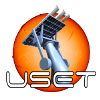Uccle Solar Equatorial Table
A brief history
The Uccle Solar Equatorial Table was constructed and put in operation in 1955-56 in preparation of the International Geophysical Year (1957-58). At that time, the USET was the most advanced solar patrol instrument. It was fully automated using and electro-mechanical programmer. This program controlled several photographic cameras (Robot 35mm motorized camera bodies with 100m film rolls), primarily on the H-alpha telescope. The automated telescope featured a photoelectric solar pointer that locked the table with all telescopes on the solar disk as well as a photoelectric dome slit pointer that controlled the dome rotation in order to keep the dome slit in front of the telescopes.
The prime instruments were the H-alpha telescope equipped with a Lyot filter and the white-light heliograph. A CaII-K chromospheric telescope was added but never entered regular operations. Next to those modern patrol instruments, the old visual 16cm refractor was used for the Uccle sunspot drawings. These same instruments had been used for all visual sunspot observations from Uccle since the early 20th century, initially on another mount in the same dome. This allowed ensuring a long-term homogeneous record.
Due to the high costs and the very demanding manual processing of photographic images, the original patrol program was finally abandoned in the mid-1970s. The observing program then concentrated on synoptic sunspot observations for about 20 years, in the framework of the Sunspot Index Data Center (IAU World Data Center for sunspots, hosted in Brussels since 1981).
Starting in 1995, a project was initiated to refurbish the USET using state-of-the-art CCD imagers in order to restore the original solar patrol capabilities of this facility. In 2002, two new imaging systems were put in regular operations: the original H-alpha telescope with its vintage Lyot filter was equipped with a new temperature regulation and a 1 mega pixel CCD camera, while a new 15cm refractor was also equipped with an identical camera for white-light synoptic observations. By 2007, the instruments were further modernized in order to increase the spatial resolution and dynamic range of the imagers and replace the aging Lyot filter (limited image sharpness and contrast). Since 2007, new cooled 4 mega pixel cameras were installed and completely new H-alpha optics replaced the historical instrument (new 8cm aperture refractor, Fabry-Perot monochromator), further increasing the quality of the solar images. A third CCD imaging system in the CaII-K chromospheric line is now in preparation. The only element that remains unchanged is the visual telescope for sunspot drawings.
The modernization of the USET is still in progress. Its control is entirely computerized with stepping-motor drive. A new solar pointer is under development. With the addition of encoders, the solar acquisition as well as the dome control should reach a high level of automation. Regarding the telescopes themselves, individual fine-pointing and focusing systems based on micrometric translation stages will allow real-time optimization of the images and the routine determination of telescope flat-field maps.
Starting in 1995, a project was initiated to refurbish the USET using state-of-the-art CCD imagers in order to restore the original solar patrol capabilities of this facility. In 2002, two new imaging systems were put in regular operations: the original H-alpha telescope with its vintage Lyot filter was equipped with a new temperature regulation and a 1 mega pixel CCD camera, while a new 15cm refractor was also equipped with an identical camera for white-light synoptic observations. By 2007, the instruments were further modernized in order to increase the spatial resolution and dynamic range of the imagers and replace the aging Lyot filter (limited image sharpness and contrast). Since 2007, new cooled 4 mega pixel cameras were installed and completely new H-alpha optics replaced the historical instrument (new 8cm aperture refractor, Fabry-Perot monochromator), further increasing the quality of the solar images. A third CCD imaging system in the CaII-K chromospheric line is now in preparation. The only element that remains unchanged is the visual telescope for sunspot drawings. The modernization of the USET is still in progress. Its control is entirely computerized with stepping-motor drive. A new solar pointer is under development. With the addition of encoders, the solar acquisition as well as the dome control should reach a high level of automation. Regarding the telescopes themselves, individual fine-pointing and focusing systems based on micrometric translation stages will allow real-time optimization of the images and the routine determination of telescope flat-field maps.
USET images can be freely downloaded as public data.
However, any public use, web based or paper publication of those data must include an explicit credit to the source:
(USET data/image, Royal Observatory of Belgium, Brussels)
(USET data/image, Royal Observatory of Belgium, Brussels)


